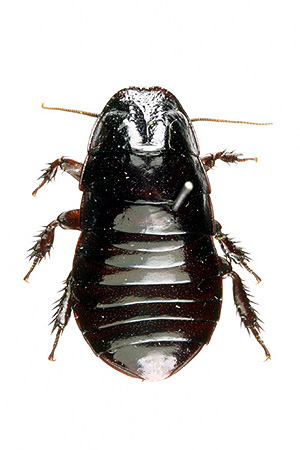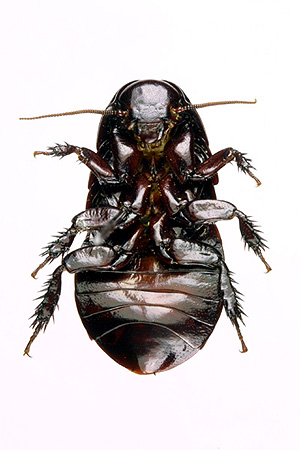갑옷바퀴
Cryptocercus kyebangensis Grandcolas
2001
몸길이는 수컷 17-21, 암컷 18-24 ㎜ 내외이다. 몸은 매끄럽고 윤이 나며 짙은 흑갈색이다. 날개는 전혀 없으며 앞가슴등판에 T자 모양으로 뚜렷하게 파인 홈과 점각이 발달한다. 주로 고산지대의 썩은 나무 속에서 집단으로 발견된다. 새끼와 어미가 어울려 아사회성 생활을 한다.


Original description:
Cryptocercus kyebangensis
Grandcolas 2001 Proc. Acad. Nat. Sci. Phila. 151: 63, figs. 1-3, 6, 8-10, 15, 16, 19.
Holotype. -SOUTH KOREA: Kyebang Mountain
(=Kyebangsan, =Gyebangsan), 1557 m, 38 ㎞ west-southwest of Kangnung;
temperate deciduous forest, 3. X. 1998 (Yung Chul Park and Philippe
Grandcolas) (MNHN); male.
Allotype. -Type locality;
female.
Paratypes. -Type locality; 6 males and 1
female (pinned), 4 males and 6 females (in alcohol) (MNHN); 2 males
and 2 females (in alcohol) (ANSP); 3 males and 3 females (pinned)
(NMNHK). Sokyebang Mountain (=Sokyebangsan), 1456 m, 32 ㎞ west
of Kangnung, temperate deciduous forest, 3. X. 1998 (Yung Chul Park
and Philippe Grandcolas) (MNHN); 1 male and 2 females.
Etymology.
-This species is named after the type locality. According to newer
Romanized spellings of Korean names, the type locality should be
now spelled Gyebang Mountain, not Kyebang Mountain. We, however,
prefer to name this new species according to the previous spelling,
which is still prevalent in geographical data bases and maps.
Description.
-Small-sized species, not slender but wide and not cylindrical but
quite flattened dorso-ventrally by comparison with other species
of the genus; coloration black or very dark brown, even on the ventral
side.
Pronotum smooth, with some low ridges or small
projections but without horns or sharp projections, and not very
developed laterally; its cephalic margin shaped as a carina only
slightly not widened in the middle and slightly concave.
Fore
femora with four, rarely three or five, apical spines on the ventro-anterior
margin; all femora with one (sometimes two) spines on the ventro-posterior
margin; all spines moderately long and robust.
Abdomen
with tergites smooth, with few and very weak punctuations and without
any other protuberances; large tergal glands similar to those described
in C. punctulatus; covered eighth sternite without projections
on the caudal margins. Sternites also smooth.
Male
subgenital plate with caudal margin regularly rounded and very slightly
protruding in the middle, between the two well-differentiated styli
which are apically rounded; with weak concavities on each lateral
margin and inner to each stylus. Male supra-anal plate subtriangular
with a clearly rounded caudal margin.
Female subgenital
plate with a narrowly truncate apex and convex subapically.
Male
genitalia. -Apical and dorsal part of sclerite L2v deeply sclerotized;
ventral and elongated part of the same sclerite with the basal part
irregularly quadrate, and the apical part medium-sized and ending
with a widened sclerotization; the apical forked part of the sclerite
R3d with two branches the ventral one is wide and rounded and the
dorsal one is straight and narrow, separated by a small rounded
unsclerotized space. Ventral phallomere very weakly sclerotized.
Female
genitalia. -Inner side of basivalvulae straight or evenly rounded
but evenly sclerotized; laterosternite IX with the ventral arm digitiform,
and the dorsal margin not sinuous. Spermatheca with short ducts,
the basal one clearly widened before the fork leading to a big and
oval terminal ampulla and a small and elongated basal ampulla; the
length of the duct leading to the terminal ampulla is highly variable.
Ootheca.
-Similar to the ootheca describes from C. punctulatus.
Measurements
(㎜, females in parentheses). - Length, 17-19.5 (17.5-19); pronotum
length, 3.9-4.8 (4-4.4); pronotum width, 6.2-7.4 (6.5-6.6).
Comments.
-This population was collected in a small valley the bottom and
the slopes of which were covered of deciduous forest. Six other
distinct populations of Cryptocercus have been sampled throughout
the whole territory of South Korea but were not included in this
account because they show morphological variation which suggests
that they are not conspecific with C. kyebangensis. We prefer
to base the present description on material the homogeneity of which
is unquestionable and which represents the populations used for
behavioral studies. Further caryological and molecular studies will
be necessary to assess how many species are present in South Korea.
Behavioral
ecology. -This species was found in rotten trunks and branches,
mostly on the ground, and it harbors intestinal protista as C.
punctulatus, C. clevelandi or C. relictus. Similarly,
families or old solitary individuals shelter in galleries and chambers.
The abundance of this species is however much lower than for C.
punctulatus; the same sampling effort in the understory resulted
in much smaller samples, about one fifth as many but a statistical
sampling analysis is needed to assess whether it is related only
to specific population parameters or both to these parameters and
to the differential abundance or distribution of the dead wood.
Such low density is in accord with the general paucity of subcortical
arthropods in South Korean forests reported by Choe (1997).
Comparison
with other species. -This species is quite distinct from others
described from North America and the Old world, although examination
of genitalia is needed for identification. We provide criteria for
the identification of C. kyebangensus, which have proved
to be very specific of this species by comparison with samples from
different locations in East Asia and North America belonging to
different species.
C. kyebangensis differs
from North American species mainly by its small size (generally
less than 20 ㎜), by obviously lacking punctuations on the last
tergites and projections on the male covered eighth sternite, by
having a male subgenital plate with a caudal margin regularly rounded
between the styli and having a very slightly medially concave pronotal
cephalic margin.
C. kyebangensis differs from
C. relictus (Russia) by having spines on the apex of the
ventro-posterior margins of middle and hind femora, by having a
caudal margin of the male subgenital plate regularly rounded between
the styli and by genitalic characters: male sclerite R3d with the
outer part not very widened and not shorter than the inner part,
male sclerite L2v stronger and deeper female basivalvulae with the
inner margin more evenly sclerotized, and the spermatheca with the
basal ampulla elongated, not oval-spherical.
C.
kyebangensis differs from C. primarius (China) by its
small size, by lacking any regosities or punctuations on the tergites,
by the female subgenital plate with well-curved margins lateral
to apex, by genitalic characters: male sclerite L2v with an apical
and dorsal part deeply sclerotized instead of apically and widely,
male sclerite R3d with the outer part rounded and moderately elongated
and not robust and fork-like, spermatheca with the basal ampulla
elongated bot not oval, and the female basivalvulae slender with
the inner margin evenly sclerotized. C. kyebangensis also
differs from C. matilei (China) by the same characters (except
for characters in male genitalia inapplicable because the male sex
is undescribed in C. matilei).
When C.
kyebangensis is compared to undescribed populations from other
regions of South Korea, the male and female subgenital plate, the
male sclerites L2v and R3d, and the spermatheca appear diagnostic
for the populations ranging in Mountains Kyebang and Sokyebang.
|
유충 |
1월 |
2월 |
3월 |
4월 |
5월 |
6월 |
7월 |
8월 |
9월 |
10월 |
11월 |
12월 |
|
성충 |
1월 |
2월 |
3월 |
4월 |
5월 |
6월 |
7월 |
8월 |
9월 |
10월 |
11월 |
12월 |
<참고문헌>
● Grandcolas P, Park
YC, Choe JC, Piulachs MD, Belles X,
D'Haese C, Farine JP and Brossut R. 2001. What does reveal Crytocercus kyebangensis,
n. sp. from south Korea about Crytocercus evolution? A study in morphology,
moleccular phylogeny and chemistry of tergal gland (Dictyoptera, Blattaria,
Polyphagidae). Proc. Acad. Nat. Sci. Phila. 151: 61-79.
● Park YC and Choe JC, 2002. Structure of female genitalia in the Korean wood-feeding cockroach, Cryptocercus kyebangensis. Korean J. Biol. Sci. 6: 65-68.
●
Park YC and Choe JC, 2003. Life history and population dynamics of Korean woodroach (Cryptocercus kyebangensis) populations. Korean J. Biol. Sci. 7: 111-117.
●
Park YC and Choe JC, 2003. Morphological differences of immature stages between males and females in a Korean wood-feeding cockroach (Cryptocercus kyebangensis). Korean J. Biol. Sci. 7: 105-109.